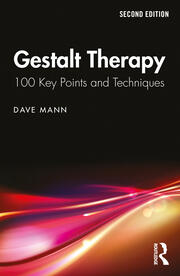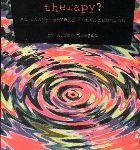Gestalt therapy offers a present-focused, relational approach, central to which is the fundamental belief that the client knows the best way of adjusting to their situation. This new edition of Gestalt Therapy: 100 Key Points and Techniques provides a concise, accessible guide to this flexible and far-reaching approach. Substantially updated throughout, topics discussed include:
- The theoretical assumptions underpinning gestalt therapy.
- Gestalt assessment and process diagnosis.
- Field theory, phenomenology and dialogue.
- Ethics and values.
- Evaluation and research.
As such this book will be essential reading for gestalt trainees, as well as all counsellors and psychotherapists wanting to learn more about the gestalt approach.
Contents:
Part 1: Maps for a Gestalt Therapy Journey – Laying the Ground, Theoretical Assumptions; 1. Gestalt Therapy: A Very Brief History; 2. So, what is Gestalt?; 3. And what is a Gestalt?; 4. Gestalt Psychology’s Laws of Perception; 5. Figure and Ground; 6. Awareness and The Awareness Continuum; 7. Contact; 8. The Here and Now; 9. Creative Adjustment; 10. Self and Selfing; 11. Structures of The Self: Id, Ego and Personality Functions; 12. Holism; 13. Individualism and Field Paradigms; 14. The Contact Boundary; 15. The Gestalt Cycle of Experience; 16. Resistances, Interruptions, Moderations to Contact; 17. The process of Introjection; 18. Ground Introjects; 19. Retroflection; 20. Projection; 21. Confluence; 22. Deflection; 23. Desensitisation; 24. Egotism/Self-Monitoring; 25. Continuums of Contact; 26. Creative Indifference; 27. Unfinished Business: The Zeigarnik Effect; 28. The Paradoxical Theory of Change; 29. The Aesthetics of Gestalt Therapy; 30. Support as ‘That Which Enables’; Part 2: Beginning the Therapy Journey – Preparations and Initial Assessment; 31. The Therapy Setting; 32. Contracts and Expectations; 33. Contact Functions – Making and Breaking Contact; 34. Assessment and Process Diagnosis; 35. How the Client “Bodies Forth”; 36. Zones of Awareness; 37. Emerging Relational Themes; 38. Planning the Journey; 39. Assessing Suicidal Risk; Part 3 The Therapy Journey – The Three Pillars of Gestalt; 3.1 Exploring the client’s situation or field; 40. Situation, Field, Life-space, Life-world; 41. Co-creation and Temporality; 42. The Therapy Space as Present Situation; 43. The Field Organises the Need and the Need Organises the Field; 44. The Id of the Situation; 45. Support in a Relational Field; 46. Shame as a Function of the Field; 47. Sensing into the Field; 48. Viewing the Field through a Developmental Lens; 49. Development – A Lifelong Process; 50. Developmental Theory – Six Fundamental Movements; 51. The Cultural Field; 52. Five Explorations; 53. Language and Metaphor; 54. Attending to the Wider Field; 3.2 Focus on Experience: Phenomenology in Gestalt Therapy; 55. What is Phenomenology?; 56. Phenomenological Enquiry; 57. Intentionality: Reaching Out to my World; 58. Transcendental Phenomenology and Husserl; 59. The Discipline of Phenomenological Reduction; 60. Existential Phenomenology; 61. Intersubjectivity; 62. Attending to the Bodily ‘Felt Sense’; 63. Energy and Vitality; 64. The Lived Body; 65. Perceiving the Whole; 66. Liminal Space; 3.3 Dialogue – Emerging through Relationship; 67. What is Dialogue?; 68. I-Thou and I-It Relating; 69. The Between; 70. Inclusion and Empathy; 71. Presence; 72. Confirmation; 73. Commitment to Dialogue; 74. Attunement; 75. Enduring Relational Themes; 76. Self-Disclosure; 77. The Relational Turn; 78. Rupture and Repair; 79. Living the Relationship; Part 4: Becoming – Transitions along the Journey; 80. Gestalt Experimentation; 81. Experimentation and Challenge; 82. Experimental Methods; 83. Polarities and the Top Dog/Under Dog; 84. Two Chairs and the Empty Chair; 85. Homework and Practicing; 86. Dreamwork; 87. Catharsis and Release; 88. Aggressing on the Environment; 89. Working with Trauma; 90. Phases in Therapy and Endings; 91. Developing Awareness of Awareness; Part 5: Ethics and Values: Key Signposts for All Journeys; 92. Therapeutic Boundaries; 93. Relational Ethics; 94. Therapeutic Use of Touch; 95. Non-Exploitation; 96. Therapist Support; 97. Gestalt Supervision; Part 6: Evaluating the Approach: Destination and Looking Back; 98. Gestalt Applications beyond 1:1 and Group therapy; 99. Looking Back and Reviewing; 100. On Uncertainty and Certainty
Author Bio:
Dave Mann is a UKCP Registered Gestalt Psychotherapist, Supervisor and Trainer affiliated with the Metanoia Institute, Gestalt Psychotherapy Training Institute and Sherwood Psychotherapy Training Institute. He is also a former Assistant Editor of the British Gestalt Journal.
Review:
“Mann’s highly accessible second edition brings gestalt therapy alive with his vignettes, and embodies it with the offer of experiments for the reader to play with. It serves as a wonderful reference text, one you can dip into as your fancy strikes you. Once you do that, you will want to go back for more” – Lynne Jacobs, PhD, Co-Founder Pacific Gestalt Institute, Los Angeles, USA






